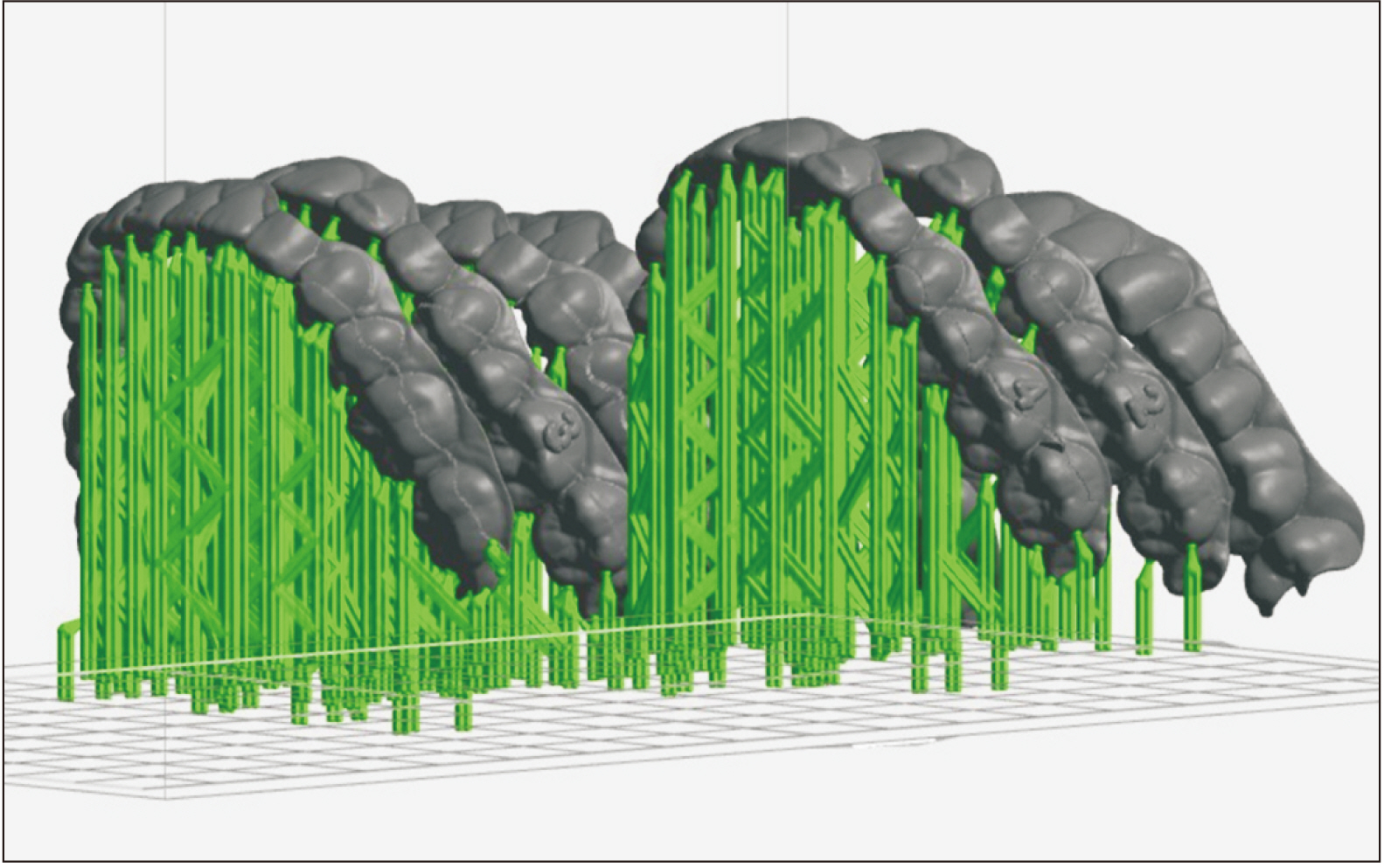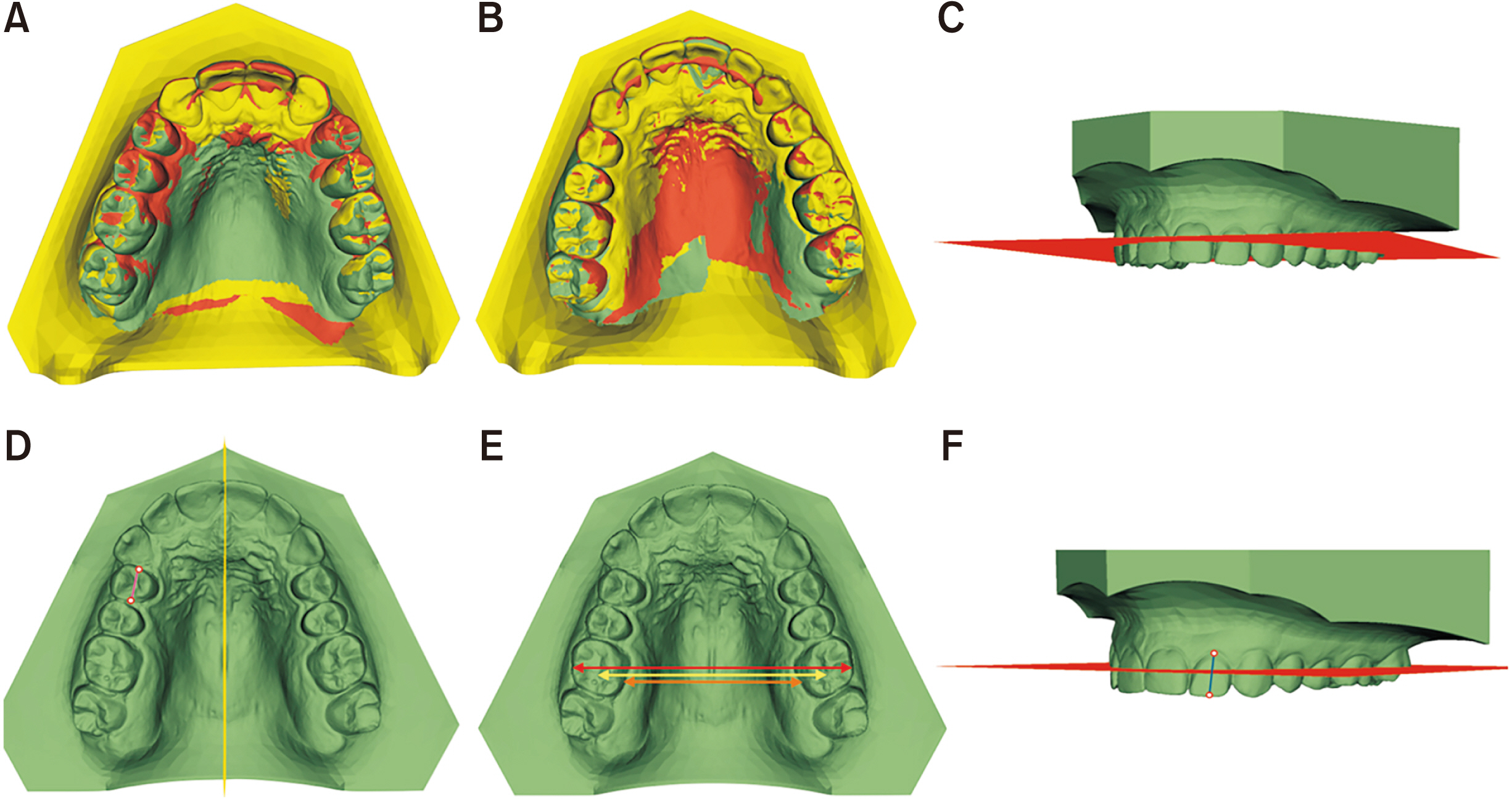Korean J Orthod.
2024 May;54(3):160-170. 10.4041/kjod23.268.
Accuracy of orthodontic movements with 3D printed aligners: A prospective observational pilot study
- Affiliations
-
- 1Department of Digital Orthodontics, University of Genova, Genova, Italy
- 2Private Practice, Torino, Italy
- 3Private Practice, Foggia, Italy
- 4Department of Orthodontics, University of Foggia, Foggia, Italy
- 5Department of Orthodontic, Università Vita Salute San Raffaele, Milano, Italy
- KMID: 2556110
- DOI: http://doi.org/10.4041/kjod23.268
Abstract
Objective
Owing to the availability of 3D software, scanners, and printers, clinicians are encouraged to produce in-office aligners. Recently, a new directprinting resin (Tera Harz TC-85DAC) has been introduced. Studies on its mechanical characteristics and biological effects have been published; however, evidence on its efficacy in orthodontic treatment remains scarce. This pilot study aimed to investigate the accuracy of teeth movement achieved with directprinted aligners.
Methods
Seventeen patients (eight males and nine females) with a mean age of 27.67 ± 8.95 years, presenting with dental rotations < 30° and spaces/crowding < 5 mm, were recruited for this study. The teeth movement was planned starting from a T0 digital dental cast. The 3D direct-printed aligners were produced using Tera Harz TC-85DAC resin. Once the orthodontic treatment was completed, a final digital cast was obtained (T1). The planned teeth positions were then superimposed onto the T0 and T1 digital models. The differences between the programmed movements and the achieved overall torque, tip, rotation, and transverse dimensions were assessed using the paired t test or Wilcoxon’s signed rank test.
Results
The overall accuracies for torque, tip, and rotation were 67.6%, 64.2%, and 72.0%, respectively. The accuracy of the change in transverse diameter was 99.6%.
Conclusions
Within the limits of the present pilot study (difficulties with abnormally shaped teeth and use of attachments), it can be concluded that 3D printed aligners can be successfully printed in-house and utilized for mildly crowded cases, with a comparable accuracy of tooth movement to that of other aligners.
Keyword
Figure
Cited by 1 articles
-
Effects of clear aligner edentulous space design on distal canine movement: An iterative finite element analysis in cases involving extraction
Seung Eun Baek, Kiyean Kim, Youn-Kyung Choi, Sung-Hun Kim, Seong-Sik Kim, Ki Beom Kim, Yong-Il Kim
Korean J Orthod. 2025;55(3):193-201. doi: 10.4041/kjod24.286.
Reference
-
1. Bilello G, Fazio M, Amato E, Crivello L, Galvano A, Currò G. 2022; Accuracy evaluation of orthodontic movements with aligners: a prospective observational study. Prog Orthod. 23:12. https://doi.org/10.1186/s40510-022-00406-7. DOI: 10.1186/s40510-022-00406-7. PMID: 35399128. PMCID: PMC8995220. PMID: 53dd43dece7f46ce98b68c092568796e.2. Ballard ML. 1944; Asymmetry in tooth size: a factor in the etiology, diagnosis and treatment of malocclusion. Angle Orthod. 14:67–70. https://meridian.allenpress.com/angle-orthodontist/article/14/3/67/54809/Asymmetry-in-Tooth-Size-A-Factor-in-the-Etiology.3. Sheridan JJ. 1985; Air-rotor stripping. J Clin Orthod. 19:43–59. https://pubmed.ncbi.nlm.nih.gov/3882756/.4. Kesling HD. 1945; The philosophy of tooth positioning appliance. Am J Orthod Oral Surg. 31:297–304. https://doi.org/10.1016/0096-6347(45)90101-3. DOI: 10.1016/0096-6347(45)90101-3.5. Papadimitriou A, Mousoulea S, Gkantidis N, Kloukos D. 2018; Clinical effectiveness of Invisalign® orthodontic treatment: a systematic review. Prog Orthod. 19:37. https://doi.org/10.1186/s40510-018-0235-z. DOI: 10.1186/s40510-018-0235-z. PMID: 30264270. PMCID: PMC6160377. PMID: ecf67b0fc3a1483599f414d8b456f8d0.6. Rossini G, Parrini S, Castroflorio T, Deregibus A, Debernardi CL. 2015; Efficacy of clear aligners in controlling orthodontic tooth movement: a systematic review. Angle Orthod. 85:881–9. https://doi.org/10.2319/061614-436.1. DOI: 10.2319/061614-436.1. PMID: 25412265. PMCID: PMC8610387.7. Jaber ST, Hajeer MY, Burhan AS. 2022; The effectiveness of in-house clear aligners and traditional fixed appliances in achieving good occlusion in complex orthodontic cases: a randomized control clinical trial. Cureus. 14:e30147. https://doi.org/10.7759/cureus.30147. DOI: 10.7759/cureus.30147. PMID: 36246088. PMCID: PMC9550299.8. Peter E, J M, Ani George S. 2022; Are clear aligners environment friendly? Am J Orthod Dentofacial Orthop. 161:619–20. https://doi.org/10.1016/j.ajodo.2021.12.012. DOI: 10.1016/j.ajodo.2021.12.012. PMID: 35016811.9. Can E, Panayi N, Polychronis G, Papageorgiou SN, Zinelis S, Eliades G, et al. 2022; In-house 3D-printed aligners: effect of in vivo ageing on mechanical properties. Eur J Orthod. 44:51–5. https://doi.org/10.1093/ejo/cjab022. DOI: 10.1093/ejo/cjab022. PMID: 33950232.10. Hertan E, McCray J, Bankhead B, Kim KB. 2022; Force profile assessment of direct-printed aligners versus thermoformed aligners and the effects of non-engaged surface patterns. Prog Orthod. 23:49. https://doi.org/10.1186/s40510-022-00443-2. DOI: 10.1186/s40510-022-00443-2. PMID: 36443390. PMCID: PMC9705625. PMID: f0c550abf11046d7a966c0cc7d9d2be1.11. Lee SY, Kim H, Kim HJ, Chung CJ, Choi YJ, Kim SJ, et al. 2022; Thermo-mechanical properties of 3D printed photocurable shape memory resin for clear aligners. Sci Rep. 12:6246. https://doi.org/10.1038/s41598-022-09831-4. DOI: 10.1038/s41598-022-09831-4. PMID: 35428796. PMCID: PMC9012852. PMID: 916cae2b1906469492ffad0957859600.12. Pratsinis H, Papageorgiou SN, Panayi N, Iliadi A, Eliades T, Kletsas D. 2022; Cytotoxicity and estrogenicity of a novel 3-dimensional printed orthodontic aligner. Am J Orthod Dentofacial Orthop. 162:e116–22. https://doi.org/10.1016/j.ajodo.2022.06.014. DOI: 10.1016/j.ajodo.2022.06.014. PMID: 35842359.13. Huanca Ghislanzoni LT, Lineberger M, Cevidanes LH, Mapelli A, Sforza C, McNamara JA Jr. 2013; Evaluation of tip and torque on virtual study models: a validation study. Prog Orthod. 14:19. https://doi.org/10.1186/2196-1042-14-19. DOI: 10.1186/2196-1042-14-19. PMID: 24325839. PMCID: PMC4384932.14. Vasilakos G, Schilling R, Halazonetis D, Gkantidis N. 2017; Assessment of different techniques for 3D superimposition of serial digital maxillary dental casts on palatal structures. Sci Rep. 7:5838. https://doi.org/10.1038/s41598-017-06013-5. DOI: 10.1038/s41598-017-06013-5. PMID: 28724930. PMCID: PMC5517608. PMID: cecbda60a212436ba47a27dd1d614ee0.15. Santos RF, Santos BFO, Fernandes VM, Caldas LD, Baldo TO, Dominguez GC. 2021; Validity and reliability of a trigonometry-based method for the measurement of tooth movement on digital models. Dental Press J Orthod. 26:e2119148. https://doi.org/10.1590/2177-6709.26.3.e2119148.oar. DOI: 10.1590/2177-6709.26.3.e2119148.oar. PMID: 34231830. PMCID: PMC8279113. PMID: 09a57551b3ca4adaaa4b2768231c5d0c.16. Castroflorio T, Sedran A, Parrini S, Garino F, Reverdito M, Capuozzo R, et al. 2023; Predictability of orthodontic tooth movement with aligners: effect of treatment design. Prog Orthod. 24:2. https://doi.org/10.1186/s40510-022-00453-0. Erratum in: Prog Orthod 2023;24:47. https://doi.org/10.1186/s40510-023-00499-8. DOI: 10.1186/s40510-022-00453-0. PMID: 36642743. PMCID: PMC9840984. PMID: 1571300819e047afab9a2eac084eec89.17. Willi A, Patcas R, Zervou SK, Panayi N, Schätzle M, Eliades G, et al. 2023; Leaching from a 3D-printed aligner resin. Eur J Orthod. 45:244–9. https://doi.org/10.1093/ejo/cjac056. DOI: 10.1093/ejo/cjac056. PMID: 36130120.18. Al-Dboush RE, Al-Zawawi E, El-Bialy T. 2022; Do orthodontic treatments using fixed appliances and clear aligner achieve comparable quality of occlusal contacts? Evid Based Dent. 23:160–1. https://doi.org/10.1038/s41432-022-0844-8. DOI: 10.1038/s41432-022-0844-8. PMID: 36526845.19. Lombardo L, Arreghini A, Ramina F, Huanca Ghislanzoni LT, Siciliani G. 2017; Predictability of orthodontic movement with orthodontic aligners: a retrospective study. Prog Orthod. 18:35. https://doi.org/10.1186/s40510-017-0190-0. DOI: 10.1186/s40510-017-0190-0. PMID: 29130127. PMCID: PMC5682257. PMID: 6a742898868040d58c7b55aee2d8b42c.20. Nguyen CV, Chen J. Tuncay OC, editor. 2006. Three-dimensional superimposition tool. The Invisalign system. Quintessence Publishing Company, Ltd.;New Malden: p. 12–32. https://www.quintessence-publishing.com/gbr/en/product/the-invisalign-system.21. Grünheid T, Loh C, Larson BE. 2017; How accurate is Invisalign in nonextraction cases? Are predicted tooth positions achieved? Angle Orthod. 87:809–15. https://doi.org/10.2319/022717-147.1. DOI: 10.2319/022717-147.1. PMID: 28686090. PMCID: PMC8317555.22. Kravitz ND, Kusnoto B, Agran B, Viana G. 2008; Influence of attachments and interproximal reduction on the accuracy of canine rotation with Invisalign. A prospective clinical study. Angle Orthod. 78:682–7. https://doi.org/10.2319/0003-3219(2008)078[0682:IOAAIR]2.0.CO;2. DOI: 10.2319/0003-3219(2008)078[0682:IOAAIR]2.0.CO;2. PMID: 18302468.23. Simon M, Keilig L, Schwarze J, Jung BA, Bourauel C. 2014; Treatment outcome and efficacy of an aligner technique--regarding incisor torque, premolar derotation and molar distalization. BMC Oral Health. 14:68. https://doi.org/10.1186/1472-6831-14-68. DOI: 10.1186/1472-6831-14-68. PMID: 24923279. PMCID: PMC4068978.24. Sachdev S, Tantidhnazet S, Saengfai NN. 2021; Accuracy of tooth movement with in-house clear aligners. J World Fed Orthod. 10:177–82. https://doi.org/10.1016/j.ejwf.2021.08.003. DOI: 10.1016/j.ejwf.2021.08.003. PMID: 34625386.25. Zinelis S, Panayi N, Polychronis G, Papageorgiou SN, Eliades T. 2022; Comparative analysis of mechanical properties of orthodontic aligners produced by different contemporary 3D printers. Orthod Craniofac Res. 25:336–41. https://doi.org/10.1111/ocr.12537. DOI: 10.1111/ocr.12537. PMID: 34569692. PMCID: PMC9544566.
- Full Text Links
- Actions
-
Cited
- CITED
-
- Close
- Share
- Similar articles
-
- Comparison of dimensional accuracy between direct-printed and thermoformed aligners
- Changes in force associated with the amount of aligner activation and lingual bodily movement of the maxillary central incisor
- Force and moment analysis of clear aligners: Impact of material properties and design on premolar rotation
- Accuracy of dies fabricated by various three dimensional printing systems: a comparative study
- Impact of lattice versus solid structure of 3D-printed multiroot dental implants using Ti-6Al-4V: a preclinical pilot study



